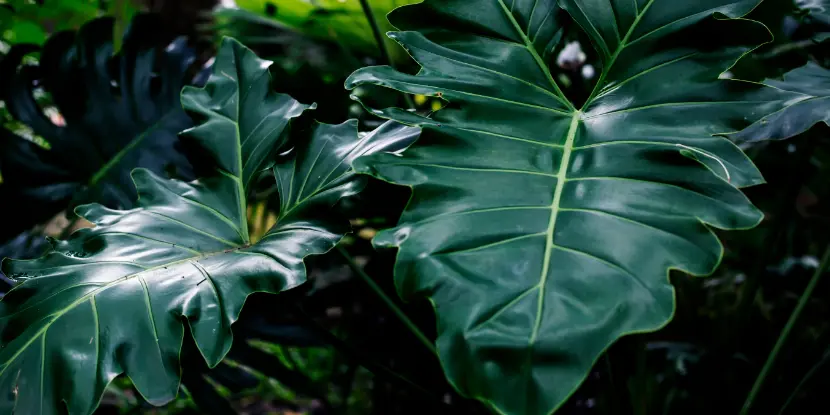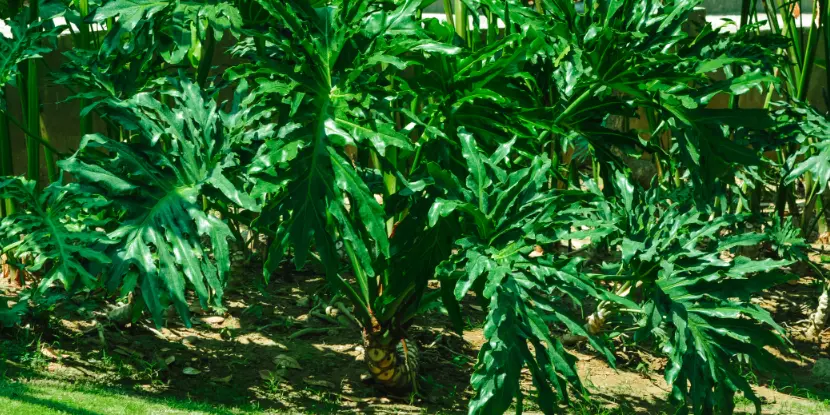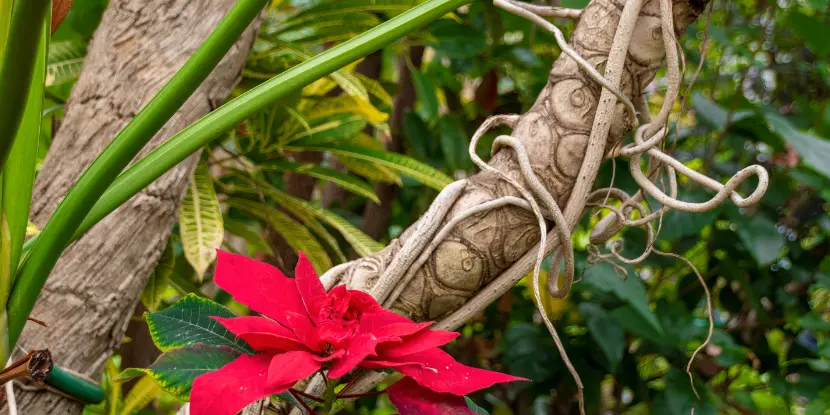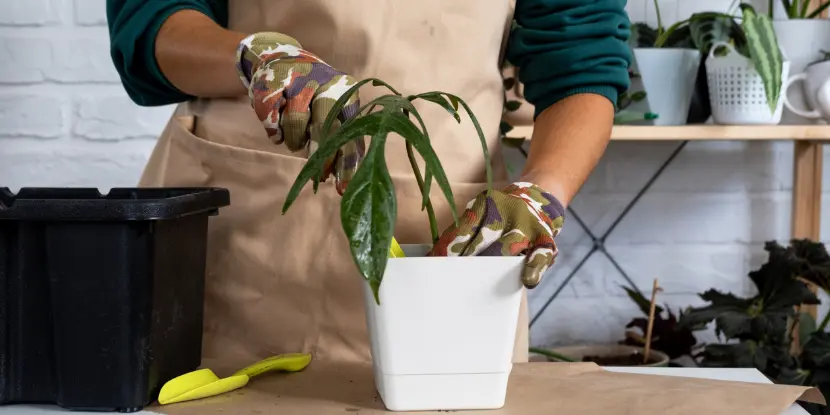Philodendron selloum (now Thaumatophyllum bipinnatifidum) is native to the rainforests of South America, where it thrives under a canopy of large trees.
This natural habitat explains why it does so well in the indirect light of homes and offices, and loves warm, humid environments that support its lush foliage.
Also called split-leaf philodendron and split-leaf elephant ear, this striking tropical plant has distinct, pinnatifid leaves growing from a main, stubby stalk. Individual leaves are unusually large, glossy green, and deeply lobed.
In Southern California, Philodendron selloum is a popular landscape plant.
Growing this tropical beauty outdoors may not be an option if you live in a colder or drier area. Still, you can enjoy the plant’s vibrant foliage and air-purifying qualities by moving it indoors.

The deeply lobed, rich green leaves of the Philodendron Selloum.
Ideal Growing Conditions
If possible, maintain indoor temperatures between 65°F and 80°F (18°C to 27°C). Avoid exposure to temperatures below 55°F (13°C), as cold drafts can harm the plant.
Aim for 60% humidity or higher to keep your Philodendron in the pink. Keep the soil moist, but not saturated.
Water & Soil
Soil should be rich, aerated, well-draining, and slightly acidic to neutral soil with a pH range of 5.5 to 7.0. A mix of peat, perlite, and vermiculite offers the optimal balance of drainage and moisture retention.
Water your Philodendron when the top inch of soil feels dry. This usually means watering once a week, but the frequency can vary due to your home’s ambient humidity and temperature.
Over-watering can quickly lead to root rot, so proper drainage is critical. During the warmer months or in dry climates, misting the leaves several times a week promotes the plant’s health and leaf shine.
Light & Philodendron Selloum
Philodendron loves bright, indirect sunlight like the filtered light of its rainforest origins. Place it near a window that receives plenty of natural light, but is shielded from direct sun.
Lower light conditions can slow growth, and leaves may lose their rich green color. Direct sunlight, especially during the harsh midday, can scorch leaves and stunt growth.
Fertilizing Philodendrons
Apply a balanced, water-soluble 20-20-20 fertilizer designed for indoor tropical houseplants. If your plant is outdoors, opt for a tree and shrub fertilizer.
Fertilize once every two weeks during the growing season (spring and summer). Dilute the fertilizer to half-strength and apply it directly to the soil, avoiding contact with the leaves.
During the winter months, when growth slows, decrease fertilization to once a month.

Phildendron selloum in a landscape.
Insects & Pests
Philodendrons are resistant to pests, but not immune. Common plant pests include:
Aphids
Small, soft-bodied insects that cluster on new growth and undersides of leaves. They feed on sap and deprive the plant of nutrients, leading to stunted growth, yellowing of leaves, and even leaf drop. As they feed, they excrete a sticky substance that can attract other pests and contribute to sooty mold.
Treatment: Rinse the plant with a strong stream of water to dislodge the aphids. Apply insecticidal soap or neem oil for severe infestations, following the product’s instructions.
Spider Mites
Tiny spider-like pests that spin delicate webs on the plant. They feed on leaf juices and prosper in dry conditions. Damage includes yellowing, curling leaves, and stunted leaf growth.
Treatment: Rinse the plant with water or apply insecticidal soap or neem oil according to the product’s instructions.
Mealybugs
White cottony insects that cluster at the base of leaves and leaf joints. Like aphids, they feed on sap and excrete honeydew, a sticky substance that encourages sooty mold growth.
Treatment: Rinse the plant with a strong stream of water, then apply insecticidal soap or neem oil.
Scale
Small, dome-shaped insects that attach themselves to the stems or undersides of leaves and feed on the plant’s sap. Scales can be hard or soft-bodied. Controlling them early is crucial, as they rapidly multiply.
Treatment: Manually remove scales with a toothbrush or gently scrap them with a fingernail. Apply horticultural oil or neem oil to smother the pests.
If possible, isolate infected plants to prevent the spread of pests. Test any treatment on a small plant section first to ensure it doesn’t react negatively.
Diseases
Philodendron selloum can succumb to several diseases, primarily due to improper care or environmental conditions.
Root Rot
Over-watering or poor drainage causes root rot, which turns roots black and mushy. Affected plants may have yellow, dropping leaves and stunted growth.
Treatment: Remove diseased roots and repot the plant in fresh soil with proper drainage. Avoid over-watering to prevent recurrence.
Leaf Spot
A bacterial or fungal infection marked by yellowish spots that become necrotic centers with a water-soaked appearance.
Treatment: Isolate the affected plant, remove the infected leaves, and apply a fungicide according to label directions. Improve air circulation and reduce leaf wetness.
Powdery Mildew
A fungal disease that appears as a white or gray powdery mold on the leaves and stems. It compromises the plant’s photosynthesis.
Treatment: Increase air circulation around your Philodendron. Avoid overhead watering. Apply a fungicide designed to combat powdery mildew.
Bacterial Leaf Blight
Manifests as dark, water-soaked lesions on the leaves, often surrounded by a yellow halo. The lesions may expand rapidly under humid conditions, causing significant foliage damage.
Treatment: Remove affected leaves to prevent the spread of the disease. Ensure the plant has adequate space and improve air circulation. Apply an appropriate bactericide, if necessary, to further control the spread.

A Lacy Tree (Philodendron selloum) growing in the Centennial Park Conservatory in Toronto, Ontario.
Pruning
Philodendron benefits from occasional grooming to remove dead, damaged, or yellowing leaves and maintain a more attractive shape.
- Trimming Dead or Damaged Leaves: Use clean, sharp scissors or pruning shears to remove dead, damaged, or discolored leaves. Make your cut near the base of the leaf, where it connects to the main stem.
- Shaping the Plant: Selectively trim back overgrown areas. Cut back to a main stem or leaf node, the small bump or nub where a leaf or branch can grow.
- Cleaning the Plant: Clean the leaves with a damp cloth to remove dust and help the plant photosynthesize more efficiently.
- Disinfecting Tools: Before and after use, disinfect your cutting tools with rubbing alcohol or a 10% bleach solution to prevent the spread of disease.
- Post-Pruning Care: Water your Philodendron after pruning to encourage recovery.
Repotting & Propagation
Philodendron selloum may outgrow its pot every two to three years. Signs that it’s time to repot include stunted growth, roots appearing through bottom drainage holes, and the soil drying out too quickly after watering.
Repotting Process
- Choose the Right Pot: Select a new pot 2-3 inches larger in diameter than the current one. It should have ample drainage.
- Prepare the Potting Mix: Use a well-draining mix suitable for philodendrons. You can also mix in perlite or orchid bark to improve drainage.
- Remove the Plant Carefully: Gently remove the Philodendron from its current pot, taking care not to damage the roots.
- Inspect and Trim the Roots: Look for any signs of root rot or damage, and trim away with sterile pruning shears.
- Place in the New Pot: Add a layer of potting mix at the bottom of the new pot. Position the plant in the center, then fill around the roots with more potting mix.
- Water Thoroughly: Water the plant until water flows freely from the drainage hole.

Transplanting a home plant Philodendron into a new pot.
Propagation Process
- Select a Stem: Choose a healthy-looking stem with at least two leaves and a visible node (the bump from which roots and leaves can grow).
- Cut: Use a clean, sharp blade to cut just below a node.
- Rooting Option 1 – Water: Place the cutting in a jar of water. Submerge the node, but not the leaves. Change the water weekly.
- Rooting Option 2 – Soil: Dip the cut end into rooting hormone (optional) and plant it in a moist potting mix. Cover with a clear plastic bag to create a greenhouse effect.
- Wait for Roots to Develop: Roots should begin forming in 3-4 weeks.
- Planting: Once the roots are a few inches long, plant the cutting in potting mix if it’s rooted in water. If rooted in soil, continue to care for it, gradually removing the plastic bag to acclimate the plant to the environment.
- Care for New Plant: Treat your new Philodendron like a mature one, with slight adjustments in watering to maintain slightly moister soil as it establishes.
Frost & Philodendrons
Outdoor Philodendrons should be protected against frost. Frost-damaged leaves should be cut back to prevent disease spread.
- Bring Indoors: Bring your potted Philodendrons indoors when a frost is predicted. Choose a spot away from cold drafts and heaters.
- Use Frost Cloth: Cover Philodenrons that can’t be moved with frost cloth or burlap in the evening. Secure the fabric so it doesn’t blow away, but allows some airflow.
- Apply Mulch: Add a thick layer of mulch around the base of outdoor Philodendrons to insulate the roots from frost damage.
- Water Plants in the Evening: Water your Philodendrons in the late afternoon or early evening before an expected frost. The water releases heat slowly overnight, increasing air humidity around the plant and reducing frost damage.
- Remove Coverings in the Morning: Remember to remove any coverings from your plants once the temperature rises. This prevents overheating and allows the plant to photosynthesize.
- Prune Frost-damaged Parts: After a frost, inspect your Philodendron for damaged leaves and stems. Prune these areas to prevent disease and encourage new growth.

A potted Philodendron selloum that can be moved indoors during cool weather.
FAQs: Caring for Philodendron Selloum
Q: How often should I water my Philodendron?
Water when the top inch of the soil feels dry. Typically, this equates to watering once weekly, but make adjustments according to your home’s humidity and light levels.
Q: Can Philodendron grow in low light?
Yes, but it thrives in bright, indirect sunlight. Low light may retard growth.
Q: What’s the best fertilizer for Philodendron selloum?
Use a balanced, water-soluble houseplant fertilizer diluted to half its strength, applied about once a month during the growing season.
Q: How do I know if I’m overwatering my Philodendron?
Signs of overwatering include yellowing leaves, especially lower ones, and a soggy or moldy smell from the soil. Ensure proper drainage and allow the top inch of soil to dry between waterings.
Q: How can I increase humidity for my indoor Philodendron?
Place a humidifier nearby, set the plant on a water-filled pebble tray, or mist it regularly.
Q: When should I repot my Philodendron selloum?
A: Repot your Philodendron every 2-3 years or when you notice roots growing through the drainage holes. Choose a pot that’s slightly larger than the current one.
Q: Can Philodendron selloum be pruned?
Pruning removes dead or damaged leaves and controls plant size and shape. Always use clean, sharp scissors or pruning shears.
Q: Is Philodendron selloum toxic to pets?
Yes, if ingested, Philodendron is toxic to cats and dogs due to calcium oxalate crystals. Keep it out of reach of pets.
Q: How do I treat root rot in my Philodendron selloum?
Stop watering, remove the plant from its pot, trim away the rotted roots, and repot it in fresh soil with proper drainage.
Q: Why are the leaves on my Philodendron selloum turning yellow?
Either overwatering or under-watering can cause yellow leaves. Assess your watering schedule and also check for proper drainage in the pot.

